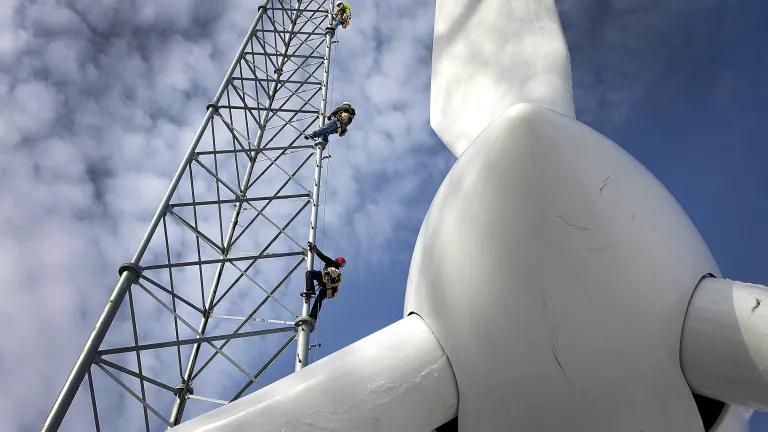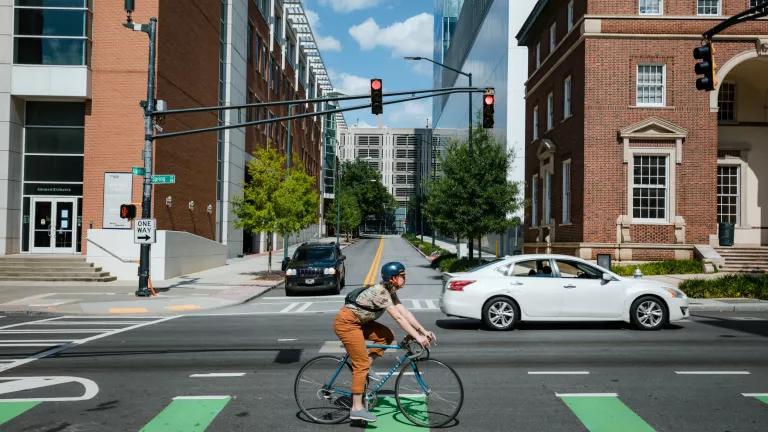Working Together: Resilience and Decarbonization
What does resilience in buildings have to do with meeting our global climate goals? A lot, it turns out.

2021 David B. Goldstein
What does resilience in buildings have to do with meeting our global climate goals? A lot, it turns out, and this blog, which is based on my presentation at the DOE-sponsored National Building Codes Conference in July 2021, explains why.
There are multiple aspects of resilience, but one of them stands out as a bridge between the decarbonization of buildings (reducing the carbon emissions by retrofits or changes in construction plans) and resilience—that is the ability of a building to remain habitable or usable for hours to weeks after an interruption in energy supply. (The interruption may be due to a storm, extreme weather, or even be part of a wildfire prevention plan.)
Ensuring habitability is a matter of life and death. Texas experienced energy shortages in early 2021 that resulted in about a hundred deaths from cold. The Northwest heatwave of early this summer caused hundreds of deaths, primarily in buildings without cooling (which is common, because hot weather is unusual in that region). The issue also arises in the wake of hurricanes and other extreme weather events that can knock out power for weeks at a time.
The main tools needed to accomplish decarbonization are also the key to habitability, we will see as we list the technical aspects of each:
Decarbonization can best be achieved by:
- reducing heat loss and gain by improving the building envelope;
- using high-efficiency electric heat pumps for space and water heating (which are far cheaper to install as well as to operate and work better if the envelope is tight);
- storing energy by pre-heating or pre-cooling water and buildings themselves;
- enabling demand flexibility (discussed next) for appliances, which is often automated and controlled through the Internet to reduce energy use when the grid is dirty;
- considering extreme peak conditions rather than usual design conditions, to keep the costs of decarbonization low and the reliability high; and
- adding solar PV on the building. PV is useful for decarbonization but is even more valuable for habitability.
These actions need to be guided by a carbon metric—something similar to a HERS rating or ERI, so that we can rank-order our investments to save the most carbon emissions.
The carbon metric will be sensitive to time of day because the electric grid is projected to be quite clean in terms of emissions at some hours of the year, especially mornings in the first half of the year, while remaining pretty dirty at others (usually late night or early morning in autumn and winter). Thus saving emissions means not only reducing energy consumption but shifting the time of use from dirty hours to clean hours.
The graph below shows how clean or dirty electricity is depending on month of the year (looking horizontally) and time of day (looking vertically). It shows considerable variation today and much more intense variation along the same pattern for 2030. Controlling demand so that it moves from the redder hours to the greener ones reduces carbon emission by taking advantage of abundant renewable energy during the green hours and avoiding electricity use in the red hours when more fossil fuels power the system.

As we take advantage of the increasing amount of renewable energy on the grid, we will see that heat pumps are an attractive decarbonization strategy, but that there is a consequence we have to avoid: the potential to create new winter peaks in electric power consumption. The projected results for the New England region are presented below:

The largest elements of the cost of electricity are the cost of transmission, distribution, and generation, all of which are sized to meet peak power demands. If we add electric equipment indiscriminately, we will risk adding to those costs. High peak demands for gas were the driver behind the Texas energy shortages of 2021.
We can mitigate this growth in peak by reducing heat gains and losses, and by continuing to improve the engineering of heat pumps to boost their cold-weather performance. Thermal storage, in the shape of pre-heated water and spaces, can also help.
Developing a carbon metric that can evaluate these and other options is straightforward, and it is already underway. Current energy codes already rely on 8760-hour- year computer models of energy consumption: it is a simple software exercise to multiply the energy consumption for each hour by an emissions factor to generate an estimate of annual carbon emissions. RESNET and ASHRAE 189.1 and 90.2 are already working on this. You can expect a draft standard from RESNET to be available for public review by late summer or early autumn 2021. The other piece of the solution is algorithms for crediting storage and demand controls. These are being developed in collaboration by RESNET and the California Energy Commission, and the first set of them should be available for public review late in 2021.
What would a habitability metric look like? I suggest that it could be based on a calculation of the highest and lowest indoor temperatures a building would reach assuming no external fuel or power all year. An all-year model would account for the fact that a disruptive event could occur at any time, and thus if the building remained habitable with no power, it would certainly remain so for ANY two or three week period.
How would this be achieved? Here is where the synergies with decarbonization come in. First, low envelope losses or gains are key—the lower the losses or gains the longer it takes for temperatures to drop or increase to uncomfortable levels. One large source of losses or gains is the windows, so the building can be designed for maximizing solar heat gains in winter and minimizing them in summer through external shades, drapes, or shutters, and by controlling solar transmission electrically with new fenestration technologies.
Building designers can match desired heat gains in winter to calculated losses to achieve comfort with minimal heating and cooling and thus achieve adequate comfort even without mechanical conditioning. The use and the positioning of thermal mass can help as well. The same amount of heat storage located internally can stabilize temperature longer than it could if it was distributed in the walls or floors. And it works twice as well if the envelope is twice as tight.
Solar generation becomes increasingly valuable for habitability: it is hard to live safely and healthily if you can’t charge your mobile phone or listen to the radio or TV to see how the emergency is progressing. It is hard to survive on food that doesn’t require refrigeration. So solar on-site with some level of battery storage is extremely valuable.
We now see one key additional synergy: the same hardware and software needed to implement flexible demand to reduce carbon emissions also can be programmed to triage energy uses based on the level of available storage and solar power. The same controls that say not to turn on the water heater when the grid is dirty and the water heater already has sufficient stored hot water can also decide whether, in an emergency, there is enough power to heat water for a shower that day. And it can assure that it is always possible to have power for critical needs such as charging phones and keeping the home healthy.
Efficient envelopes will include air tightness, such that ventilation air for health and comfort purposes will be supplied by fans. The controller could, in the event of a loss of power, choose a level of ventilation that is consistent with battery power and health but might compromise comfort (meaning odor reduction).
Cool roofs—roofs that reflect sunlight and allow heat to dissipate by radiation—are an important element of envelope improvement. They not only reduce indoor temperatures for non-air-conditioned buildings, but also reduce the outdoor air temperature for the whole community.
Thus the very same actions that improve carbon performance also enhance habitability.
These concepts of habitability are not new: I developed them for my Ph.D. thesis in the late 1970s. I found that even with then-available technology, it was possible to maintain adequate comfort all year in all North American climates without heating or cooling.
The development of a habitability metric may require new software algorithms. When I did my thesis, the energy simulation models were not very good at predicting indoor temperature without heating or cooling. They were designed to do the reverse, predict heating and cooling energy holding temperature constant. But it is not that difficult to do, and may well have been done by now.
A habitability metric could also be valuable for regions where space conditioning is unaffordable or unavailable, such as in remote rural villages or areas of widespread poverty. It would help promote such technologies as cool roofs, which provide reductions in outdoor as well in indoor temperatures when deployed across a whole city.
So resilience—at least one aspect of it—and decarbonization are mutually supporting. Some technologies that might be hard to justify economically for a single purpose, such as battery storage, may pencil out when they meet two different needs. Others can be justified both for carbon reductions and for resilience, making them even more valuable than if they only served only one public purpose.



